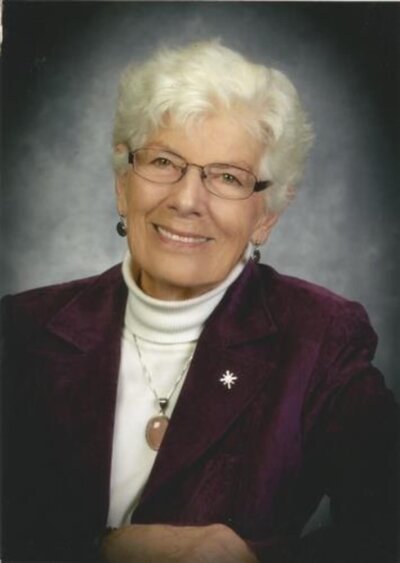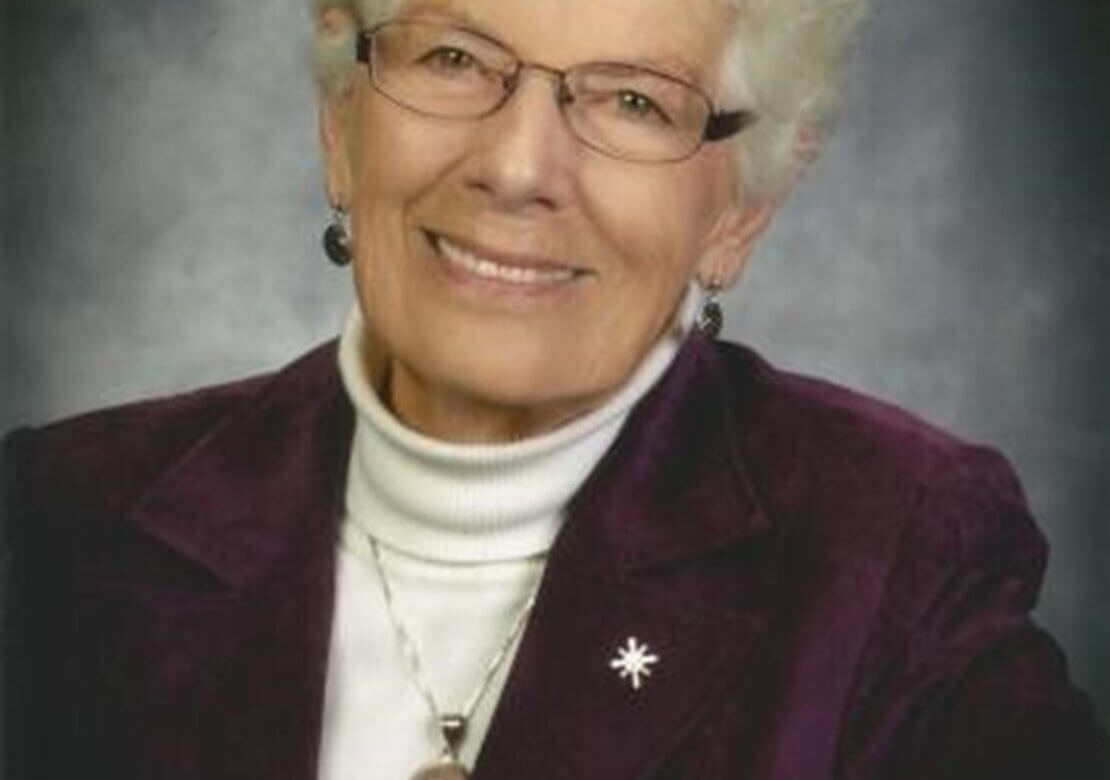Mavis Gillie: Indigenous Advocate and Environmentalist
Volume 35 Issue 7, 8 & 9 | Posted: October 4, 2021

Mavis Marie Gillie was born in Prince Albert, Saskatchewan in 1927, one of six children of British immigrant parents. Charles Chisholm, her father, had come to Canada and served in the Canadian army in WW I. After her mother, Violet (nee Mee), arrived in Canada, they worked a small holding of Soldier’s Settlement land in Saskatchewan.
Eventually Mavis became a secretary in Prince Albert and taught Sunday School. In 1947 she was chosen to attend the World Conference of Christian Youth in Oslo, Norway. On her return, after visiting relatives in Britain, Mavis rejoined her family after they had moved to Victoria. She became school secretary at S.J. Willis school and there she met Bernard Gillie, the school principal. They married in 1959.
In 1962 Bernard was appointed Director of Education for the North West Territories so the family moved to Fort Smith and then in 1969 to Yellowknife. They had two daughters, Susan and Margaret. During her ten years in the north, Mavis became increasingly aware of problems faced by Indigenous people and she became an advocate for them in the NWT.
In 1973 the Gillies returned to Victoria to a farm in Strawberry Vale, where Mavis gardened and kept dogs and ponies. She also began more than forty years of working tirelessly and without pay to address the problems of Indigenous people. Her strengths were many.
She was charming but courageous. She was forceful but sensitive to the needs of those around her. She always did thorough research. Sister Marie Zarowny, of the Sisters of St. Ann and Coordinator of the Office of Social Justice for the Roman Catholic Diocese at this time, describes Mavis as someone who “never flinched” from “telling truth to power”.
Mavis joined the Anglican Primate’s World Relief and Development Fund. She was a founding member of the Public and Social Responsibility Unit of the Anglican Church of Canada. She was also a founding member of Project North, an ecumenical social action group that existed from 1975 to 2000. It is now called the Aboriginal Rights Coalition (ARC). Project North focused on raising public awareness and working for healing and reconciliation.
Here are some examples of issues Mavis worked on. In the 1970s Mavis worked with the Dene opposing the McKenzie Valley pipeline. The Run for Justice in 1988 from Hazelton to Victoria was sponsored by Project North to raise funds for the Gitxsan and Wetsuwet’en to fight for the Delgamuukw Aboriginal Title lawsuit.
In 1996 the Nisga’a opposed the Amax molybdenum mine dumping tailings into the Nass River. To help them Mavis made submissions to the Select Standing Committee on Aboriginal Affairs. She also represented Project North before the Environmental Appeal Board. She helped the Tsawout in their fight against the marina proposal for Saanichton Bay.
Mavis always pursued fairness and truth. She organized media events and free information packages. She lobbied cabinet ministers and appeared before committees and commissions. She was a catalyst for change. In 1991 Mavis was given the Award of Merit by the Anglican Primate of Canada.
She continued her work. In 1995 she moderated the three-part TV series “Hearing the Native Voice” and persuaded UVic law professor Hamar Foster to speak in it. In 2001 Mavis again made a submission to the Select Standing Committee regarding the Aboriginal Rights referendum of the Campbell government.
The eight questions in the referendum were criticized by Angus Reid as being confusing. There were double negatives, questions too broad to be meaningful, and questions about issues beyond provincial jurisdiction. The referendum was felt to be ‘amateurish and stupid’. And since their land had been taken without treaty, the First Nations felt the referendum was a distortion of historical reality. The land was theirs anyway.
Judy Tethong, a close friend of Mavis, described the ballot burning event they attended along with prominent First Nations leaders such as Dr. Judith Sayers (former chief of the Hupacasaath) and master carver Butch Dick. The ballots were in a canoe and set alight by a flaming arrow.
In May of 2009 Mavis made a written submission on behalf of ARC to the Canadian Environmental Assessment Panel on behalf of the Tsilhquot’in opposition to the Prosperity Mine proposal. She also helped the Tseycum raise funds for repatriation of ancestral remains. She helped the Haida regarding the Cinola gold Mine proposal. She helped the Nuu-cha-nulth with the Meares Island injunction. In 2010 Mavis helped to recover a Talking Stick that had been given to ARC by the Gitxsan so that ARC could speak for them. It had gone missing. After it was found, there was a ceremony in which the Stick was gifted to the U Vic law school and Mavis was instrumental in organizing that ceremony.
Bernard died in 1991 and in 2006 Mavis moved to a bungalow in Oak Bay. She has been a long-time member of St John the Divine. In 2014 she was awarded an Honorary Doctor of Laws degree by the University of Victoria. She also received the Governor General’s Caring Canadian Award.
Information for this biography came from her daughter Margaret and Mavis’ many admirers and colleagues such as Doreen Hunter and professors Hamar Foster and John McLaren. Judy Tethong, a life-long advocate for freedom of Tibet, remembers anecdotes that capture Mavis’ character:
In 1975 Judy and her husband T.C. arrived in Victoria from India after work with Tibetan refugees. They had two young children and were homesick and unhappy. One day Mavis appeared on their doorstep with food (fruits and vegetables from her garden) and friendship.
Mavis had once worked with Judy’s father on the Primate’s Fund and had heard about Judy’s plight. Thus began a long friendship. That December, Judy was awarded the Order of Canada but she was unable to go to Ottawa for the March ceremony because she was pregnant with her third child. In the autumn of 1976 Judy, T.C. and the baby went to Ottawa and Mavis looked after the two older children (aged six and two).
Another anecdote concerns the visit of some Chinese war ships on a training visit to Royal Roads. Judy planned various interventions to publicize the Tibet situation and Mavis was her accomplice. The most daring escapade involved tours that were being offered on the ships. Mavis and Judy used Mavis’ car since Judy’s “Free Tibet” bumper sticker would not have been allowed.
They wore “Free Tibet” T-shirts under their clothes and had Tibetan flags hidden in their belongings. They managed to get on a ship as tourists. They evaded their ‘minder’’ and quickly put “Free Tibet” stickers on the guns of the boat. Meanwhile military police were arriving with the Chinese consul. They managed to get off the boat before being detected.
Mavis Underwood of the Tsawout First Nation describes Mavis Gillie as “a force of nature” who “coaxed the settler population to reflect on how they live in BC” and as someone who “is deeply loved and admired”.

